Police Files
These photographs of Russian prisoners tattoos were collected by Arkady Bronnikov from the mid-1960s to mid-1980s. A senior expert in criminalistics at the USSR Ministry of Internal Affairs for over thirty years, part of his duties involved visiting correctional institutions of the Ural and Siberia regions.
It was here that he interviewed, gathered information and took photographs of convicts and their tattoos, building one of the most comprehensive archives of this phenomenon. In 2013 FUEL acquired this collection consisting of over 1,000 photographs. A selection of these photographs alongside official police papers authored by Bronnikov from the Soviet period were published by FUEL in September 2014 and in 2018.
The Bronnikov collection was made exclusively for police use, to further the understanding of the language of these tattoos and to act as an aid in the identification and apprehension of criminals in the field. The photographers only consideration was the recording of the body for practical purposes. Unimpeded by artistry, these vernacular photographs present a guileless representation of criminal society. The tiny fraction of prisoners documented here unintentionally betray their human side. Every image discloses evidence of an inmate's character: aggressive, vulnerable, melancholic, conceited. Their bodies display an unofficial history, told not just through tattoos, but also in scars and missing digits. Closer inspection only confirms our inability to comprehend the unimaginable lives of this previously unacknowledged caste.
Police Files 1

The man is a character from a TV crime series shown during the Soviet era - a brutal gang leader. In the story, he ends up in jail. In this tattoo, however, he defends himself against the Soviet power and fights back. On his submachine gun are the letters 'US' which along with the skyscrapers and dollar bills embody the ideological opponents of the Soviet Union and indicate a hatred of the government.
The eyes signify that ‘I am watching over you’ (the other inmates in the prison or camp). The epaulette tattooed on the shoulder denotes the inmates 'rank' among the criminal caste.
Scroll for more
Police Files 2
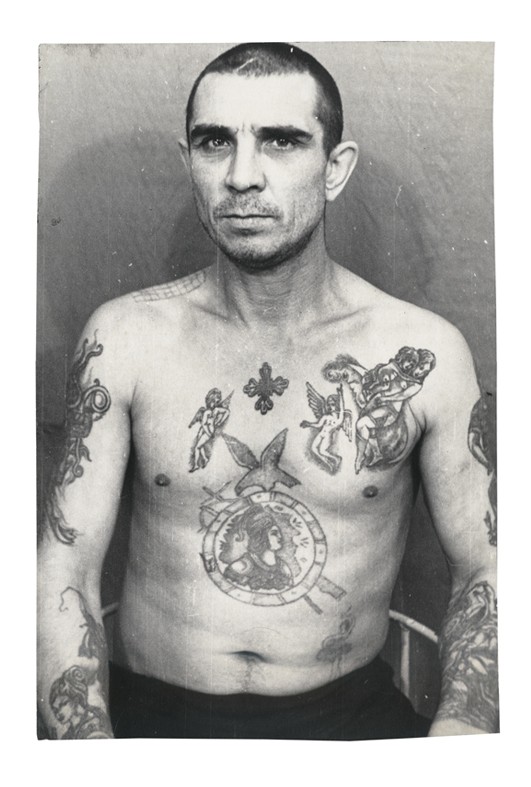
The tattoos on this inmate mimic those of higher-ranking criminals and indicate he has adopted a thieves’ mentality. However, he does not wear the ‘thieves’ stars’, he is not a vor v zakone (thief-in-law) and therefore holds no real power among this caste.
As soon as normal inmates enter the mass population of the ‘zone’ (either a prison or a camp), they realise that the thieves are in charge. They copy both their tattoos and mannerisms in an attempt to elevate their status. For self-protection they need to show themselves to be exceptional, experienced, brave and seasoned men. In addition to fear, respect and the obedience of friends, their tattoos are intended to demonstrate a desire for self-assertion and the conquest of authority in the criminal environment.
Scroll for more
Police Files 3
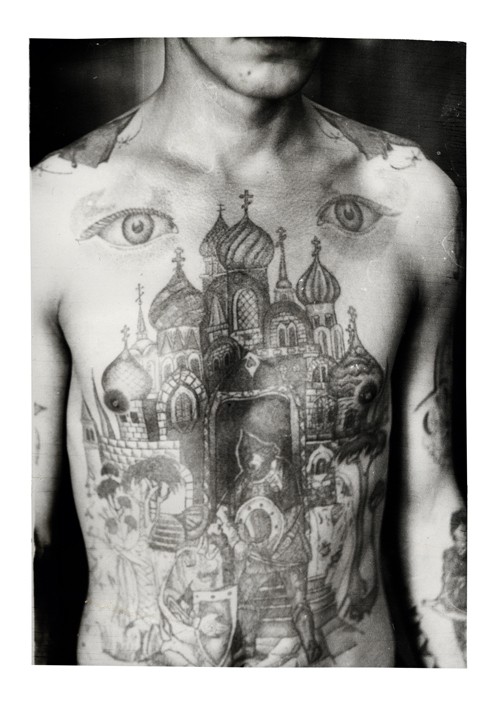
The eyes on the chest signify ‘I can see everything’ and ‘I am watching’. Battle scenes and knights in armour represent executioners or overseers sometimes known as ‘fighters’. They act according to the commands of the pakhan (the head of a group of thieves, an ‘authoritative thief’), beating up or raping other inmates. They may also murder other prisoners who have been found ‘guilty’ by the pakhan. Many of these tattoos are based on ancient Russian legends.
Scroll for more
Police Files 4

Text on the stomach reads ‘Man is wolf to man’. Text across the arms reads ‘Live in sin, die laughing’.
A pirate with a knife in his teeth is often accompanied by the acronym ‘IRA’ (a Russian female name) written on the knife, which stands for Idu rezat aktiv (I’m off to kill the activists). Worn by otritsaly (prisoners who refuse to submit to the prison rules) it denotes an inclination to brutality, sadism, and a negative attitude towards activists – prisoners who openly collaborate with prison authorities.
Scroll for more
Police Files 5

Lenin is held by many criminals to be the chief pakhan (boss) of the Communist Party. The letters BOP, which are sometimes tattooed under his image, carry a double meaning. The acronym stands for ‘Leader of the October Revolution’ but also spells the Russian word VOR (thief). Often tattoos with portraits of Lenin and Stalin are intended to show patriotic feelings. However, some prisoners had portraits of Lenin and Stalin tattooed on their chest for ‘protection’, as it was commonly believed that the guards were forbidden to shoot at an image of their great leaders.
Scroll for more
Police Files 6
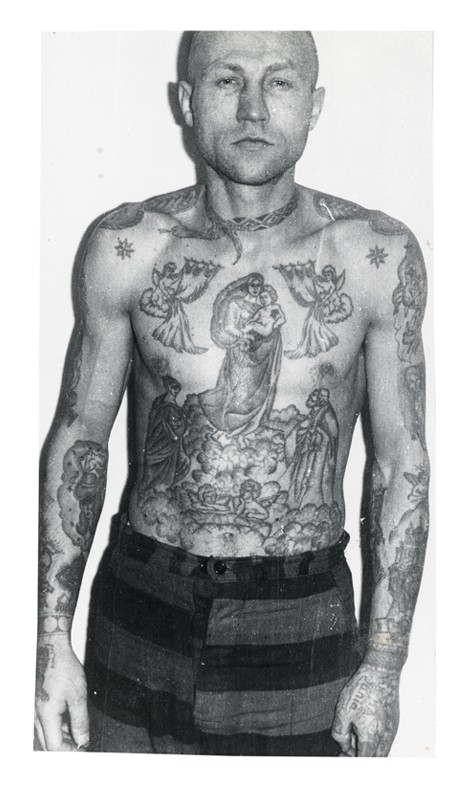
A snake around the neck is a sign of drug addiction. Most inmates are either alcoholics or substance abusers. Their crimes are often committed while in a state of intoxication.
The prisoners are divided into castes. One of these castes is made up of the criminal elite called blatniie. They are commonly known as ‘blue’, because their bodies are blue from the tattoo dye that covers them. These are experienced criminals who have committed many crimes and have many previous convictions.
The trousers worn by this inmate are part of the uniform of a special regime colony, the strictest type of regime in the Soviet Union. Criminals sent here are known as osobo opasnim retsidivistom (especially dangerous recidivists), who have carried out grave offences such as murder or paedophilia. They are assigned to harsher and more restricted regimes of detention than other prisoners, and are not subject to be released on parole. Their striped clothing acts partly as an aid to identification in the event of escape.
Scroll for more
Police Files 7

The double-headed eagle is a Russian state symbol that dates back to the 15th century and was used by Peter the Great. In 1993, after the fall of Communism, it replaced the hammer and sickle as the coat of arms of the Russian Federation. This photograph taken in the Soviet period shows this emblem tattooed as a bold symbol of power and rage against the USSR. The Statue of Liberty implies a longing for freedom, while the dark character holding a gun denotes a readiness to commit violence and murder.
The eyes on the chest signify ‘I can see everything’ and ‘I am watching’, the powerful tattoo of a criminal ‘overseer’.
On the arm beneath the skull is the Latin phrase Memento Mori meaning ‘Remember that you will die’.
Hinges (like the one on the bearers right arm) are commonly tattooed on to the interor of the elbow joints – an example of prison humour.
Scroll for more
Police Files 8
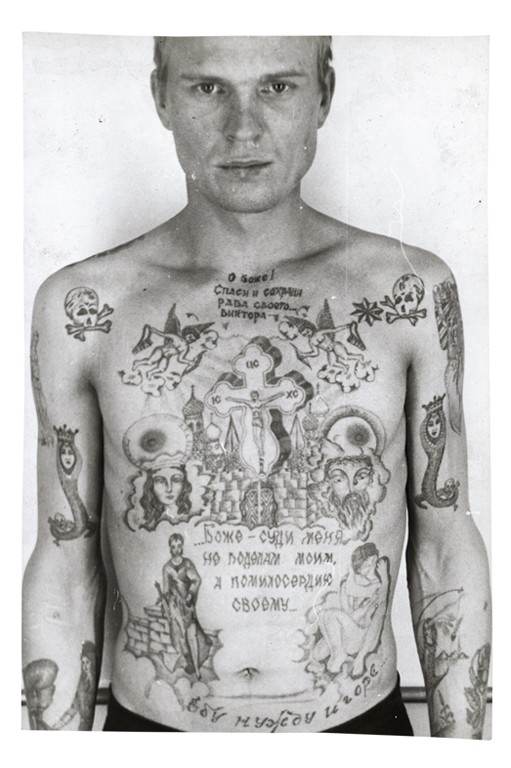
Text above the cross reads ‘O Lord, Save and Protect your servant Viktor’, text beneath reads ‘God do not judge me by my deeds but by your mercy’. Text above the waist reads ‘I fuck poverty and misfortune’.
The skull and crossbones show that the prisoner is serving a life term. The single eight-pointed star denotes that he is a ‘semi-authority’ among thieves. The girl ‘catching’ her dress with a fishing line on his left forearm is a tattoo worn by hooligans and rapists. The snake coiled around human remains (positioned on the middle third of each arm) is a variation on an old thieves’ tattoo. The snake is a symbol of temptation; here the snake’s head has been replaced by that of a woman: the temptress. Tattooed on the right side of the stomach is a version of Judith (1504) as painted by Giorgione: this is intended as a symbol of a scheming, seductive woman who betrays a noble man.
Scroll for more
Police Files 9

Text across the eyelids reads ‘DON’T / WAKE’.
Eye tattoos are made by inserting a metal spoon under the eyelid so that the ‘needle’ doesn’t pierce the eye.
Scroll for more
Police Files 10

This thief is tattooed in the traditional fashion with a large image (usually a church or a cross) taking up the most important part of the body: the chest. This is intended to show a devotion to the thieves’ traditions and stand as proof that his body is not tainted by betrayal, that he is ‘clean’ before his fellow thieves. The number of cupolas on the church signifies the number of convictions (in this case six).
On the left leg a sailing ship with a white body, shaded sails and flags on the masts is the distinctive sign of a ‘nomadic traveller’, a migrant offender who travels to various cities to commit theft. On the right leg is a genie emerging from a lantern. The sign of a drug addict, this can also mean that the bearer was convicted of a crime while under the influence of narcotics.
Scroll for more
Police Files 11
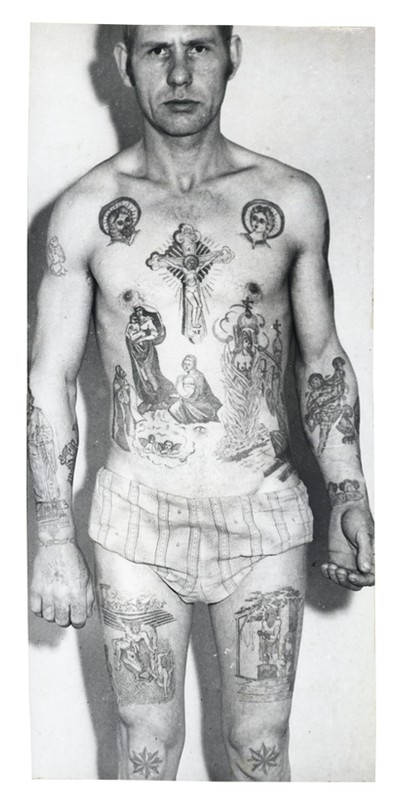
On the thigh a hooded executioner with an axe stands above a half-naked woman, a common tattoo on persons convicted of the murder of a relative (or relatives). Its secondary meaning is ‘Death to traitors’.
The naked woman being burnt on a cross symbolises a conviction for the murder of a woman. The number of logs can denote the number of years of the sentence.
The naked woman entwined in a snake on the forearm refers to the ancient story of the serpent-temptress. This tattoo means that the owner was coerced into committing a crime by a woman. If this type of tattoo appears on the back it means the bearer is a gunsel (a passive homosexual). In this instance the image is intended to give the active homosexual the illusion of copulating with a woman.
Scroll for more
Police Files 12

Text on the bells reads ‘Gentlemen Communist-Satanists, damn you for my hungry childhood!’
Church bells without a chain mean the wearer has served an entire custodial sentence, literally ‘from bell to bell’, or ‘waiting for the bell to ring’ (to be free). A window with bars means that the inmate has been locked in a special correctional school in the penal colony.
Tattooed on the stomach is the headquarters of the Council of Ministers of the Soviet Union (the state body that ran the country). The predator cats (panther, lion, leopard) on the monument in front of the building are a ‘grin’, a statement against the authorities and their laws.
Scroll for more
Police Files 13

On his right leg is the acronym ‘SLON: S malih Let Odni Neschastya’ (Only Misfortunes from an Early Age). Text under this reads ‘Here is what [is killing us]’. Text at the top of the left leg reads ‘Few roads have been walked’. Text by the knee reads ‘Love’. Text on the shin reads ‘It [the leg] walks around the zone’.
The theatre masks on the right leg represent happiness (before prison) and sadness (after prison). The dagger, cards and money underneath are a variation of the popular tattoo ‘These are the things that destroy us’.
Scroll for more
Police Files 14
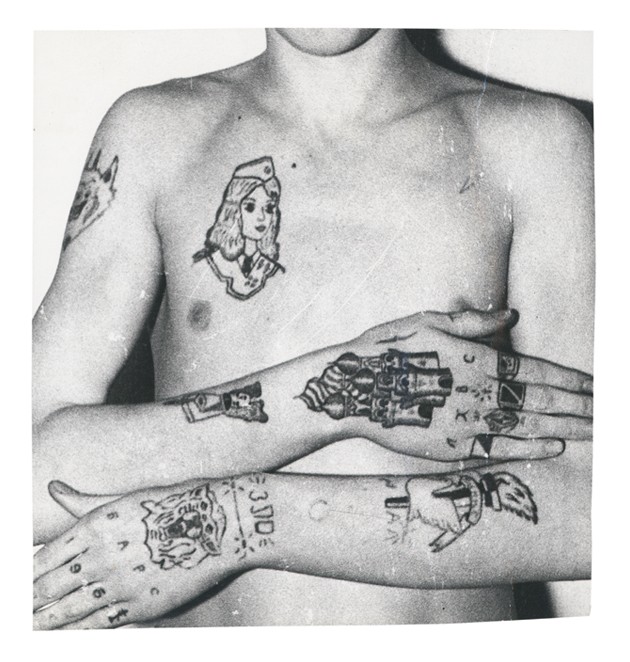
Text on the left wrist reads ‘ZLO’ (Russian for ‘evil’) interpreted as I’ll have revenge on all the cops. Text on the left hand is the acronym ‘BARS’ (Russian for ‘snow leopard’) meaning Beat up activists, kill the bitches. On the fingers ‘196†’ (date of birth). The last number has been replaced with a Russian Orthodox cross, common practice when the bearer wants to appear older than his real age. Text across the knuckles reads ‘LHVS’ Legavim Huy Voram Soboda (To trash cops the dick, to thieves freedom); if asked the meaning of this acronym by the authorities, the standard reply would be Lublu Halvu Varene Sahkar (I love halva, jam and sugar).
The girl in Nazi uniform tattooed on the chest does not necessarily represent a fascist viewpoint, but an attitude of antagonism towards the Soviet system.
Scroll for more
Police Files 15
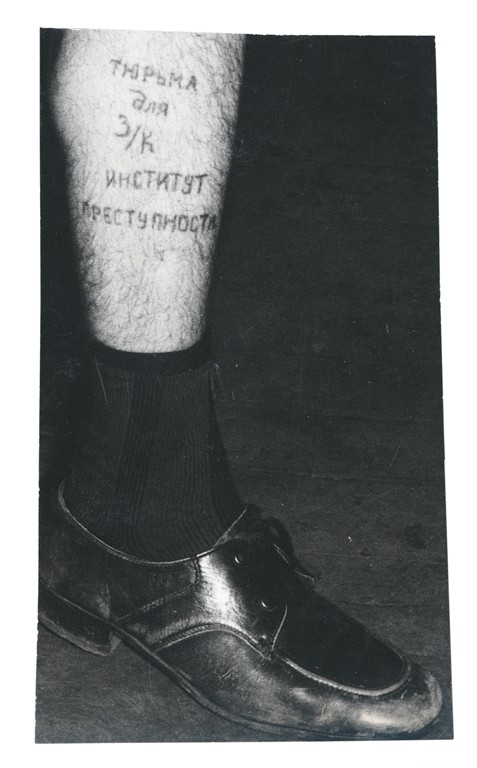
Text on the leg reads ‘Prison for a zek is a university of crime’.
This tattoo means that an ordinary person who is sentenced for a minor offence will inevitably improve his criminal skills in prison, as professional criminals share their experience. For example, pickpockets will teach others how to make sure the victim feels nothing as their pockets are emptied of valuables. Even if a person has committed a crime in error, when he leaves prison he will be more likely and able to commit crimes purposefully and professionally. The reality is that penal institutions don’t correct inmates, even though they were once called ‘Correctional Labour Institutions’. Today they are known as ‘Institutions for the Execution of Sentences’, so they are no longer required to deal with the problem of correction.
Scroll for more
Police Files 16

This prisoner is a victim of syphilis and has suffered severe scarring to his face, eyes and mouth. In the prisons and colonies male or female prisoners suffering from venereal diseases (such as syphilis) are known as buketniki (bouquet holders). They are also nicknamed after army ranks, depending on how advanced their condition is, for example, ‘Kolka whored around without taking any precautions; yesterday the medic told me that he was already a “lieutenant”.’ (An inmate suffering from second-stage syphilis is known as a ‘colonel’, third-stage a ‘general’).
The figure of the writer is known as a ‘scribe’ and is worn by pickpockets who use sharpened objects to help them commit their thefts. Sharpened rings, coins and razors are used to slice open the bags and pockets of their victims without their knowledge. The burning candle is a traditional thieve’s motif and carries the messages ‘The quiet life melts like wax’, or ‘My destiny is the light of one candle. I live until my candle burns out’. The grille of the cell window means ‘I was born in prison’ and ‘My destiny – the big sky in squares’.The pirate on the arm means that he is inclined to sadism, and has a negative attitude to those who embark on a path of correction. The cowboy on the other arm displays a tendency towards risk-taking and adventure.
Scroll for more
Police Files 17
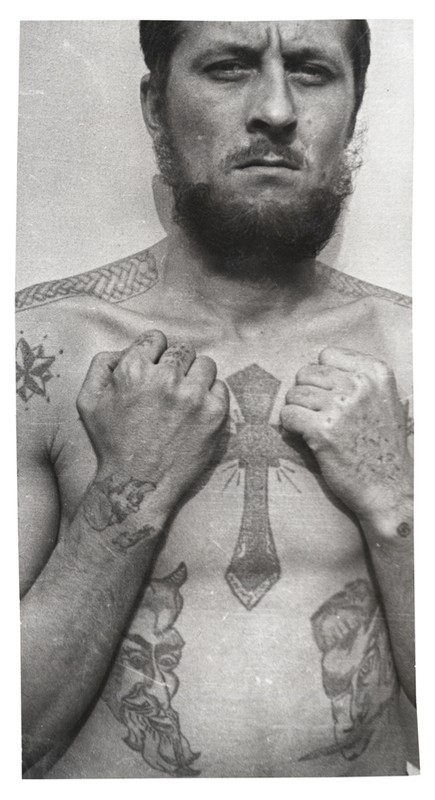
This man is an Estonian political prisoner with one star, denoting the status of a semi-authority. He is a nationalist who fought for sovereignty in the Baltic republics, a common practice in Latvia, Lithuania and Estonia following the collapse of the Soviet Union. He was imprisoned in the same colony as Aleksandr Solzhenitsyn and is mentioned in his writing.
Scroll for more
Police Files 18
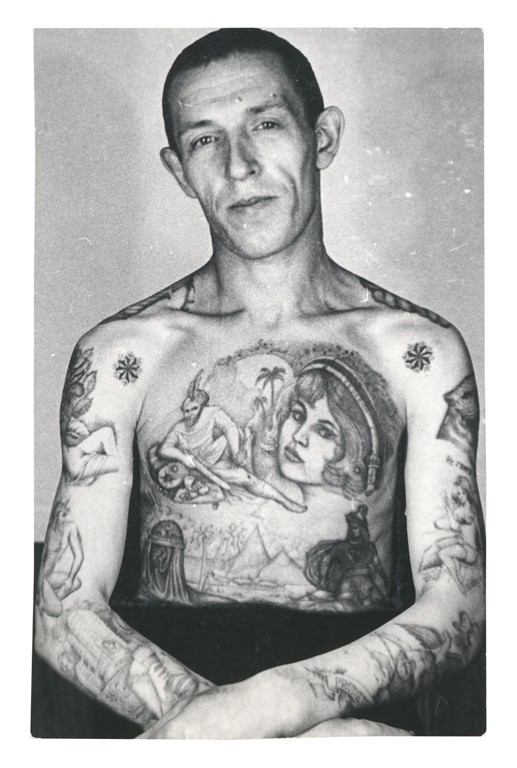
The warrior carrying a sword (stomach) and the dagger piercing through the skin (neck) mark this criminal as a murderer. The 'thieves stars' on the clavicles denote his status as an 'authority'. The epaulette on his left shoulder is also a display of 'rank'.
The design of epaulettes tattooed on to the shoulders is adapted either from a pre-Revolutionary uniform or an existing Soviet one; both indicate the bearer has a negative attitude towards the system. They are worn by high-ranking criminals who might also have a corresponding nickname such as ‘major’ or ‘colonel’. Epaulettes with three little stars or skulls are deciphered as: ‘I am not a slave of the camps, no one can force me to work’; ‘I am captive, but I was born free’; ‘I’m a colonel of the zone – I will not sully my hands with a wheelbarrow’; ‘The strong win – the weak die’; ‘Horses die from work’.
Scroll for more
Police Files 19
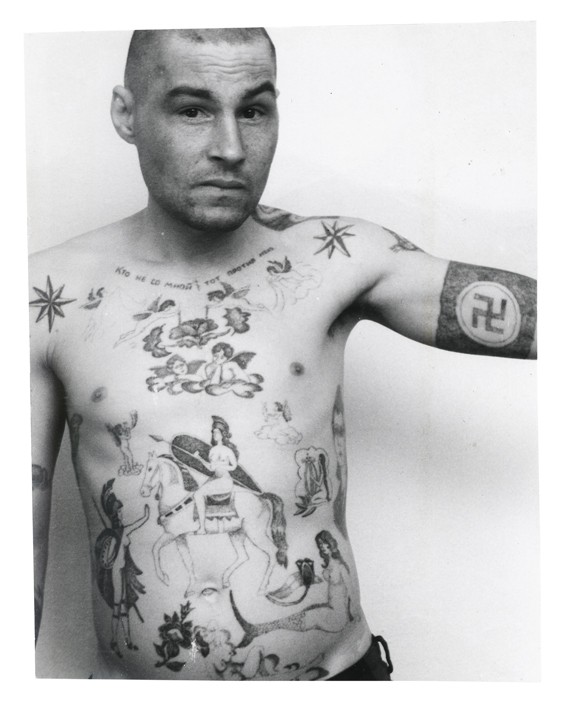
Text across the chest reads ‘He who is not with me is against me’.
The swastika may mean that the owner has fascist sympathies, though they are more usually made as a protest and display of aggression towards the prison or camp administration. During the Soviet period the authorities often removed these tattoos by force either surgically or by using an etching method.
A tattoo of a mermaid can indicate a sentence for rape of a minor, or child molestation. In prison jargon the nickname for a person who commits this type of crime is amurik meaning ‘cupid’, lohmatii ‘shaggy’, or a universal ‘all rounder’. They are forcibly ‘lowered’ in status by other prisoners.
Scroll for more
Police Files 20
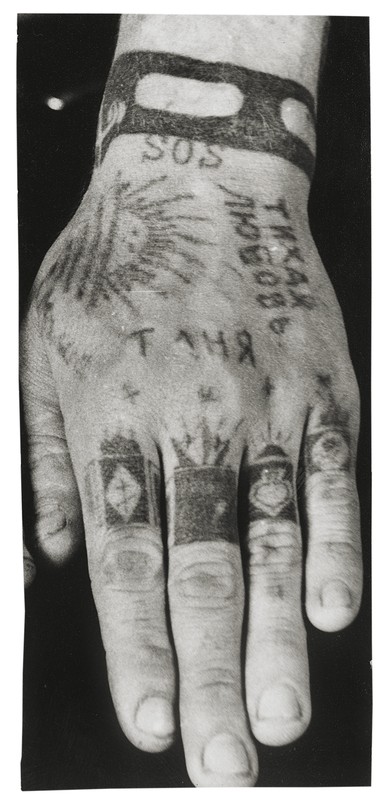
The acronym ‘SOS’ variously stands for Spasite Ot Syda (Save me from judgment); Spasi, Otets, Syna (Save me, father, your son); Suki Otnyali Svobodu (Bitches robbed my freedom). Crosses on the knuckles: trips to the zone; each cross represents a sentence served. Typically these tattoos are made by house-burglars, or ‘tiger-beetles’ as they are referred to in the criminal environment. These tattoos are intended to show other inmates that the bearer is incapable of duplicity, that he will not cooperate with the administration. Text across the hand reads ‘Tanya’ (womans name). Text above the rising sun reads ‘Quiet Love’.
A manacle on the wrist indicates a prison term of more than five years, if they are tattooed on both wrists, more than ten years. The long rays of the sun stand for convictions (usually for pickpocketing), the shorter rays between them denote imprisonment by a court.
Scroll for more



















